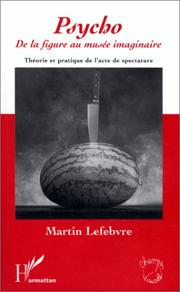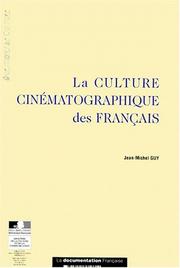| Listing 1 - 10 of 33 | << page >> |
Sort by
|
Book
Abstract | Keywords | Export | Availability | Bookmark
 Loading...
Loading...Choose an application
- Reference Manager
- EndNote
- RefWorks (Direct export to RefWorks)

ISBN: 9782894890356 2894890354 Year: 1997 Publisher: Montréal: L'Harmattan,
Abstract | Keywords | Export | Availability | Bookmark
 Loading...
Loading...Choose an application
- Reference Manager
- EndNote
- RefWorks (Direct export to RefWorks)
Que retient-on d'un film ? Que se produit-il lorsqu'un film laisse son empreinte sur la cire molle de notre mémoire ? Cet ouvrage étudie entre autres le rôle de l'imagination et de la memoria pour comprendre comment le spectateur s'approprie le film qu'il regarde. Le résultat de ce processus est appelé figure. C'est le fondement de la culture filmique et l'artefact principal de ce musée imaginaire du cinéma que chaque spectateur possède et où il conserve ce qu'il a retenu du cinéma. L'enquête est menée à partir d'un film unique et, plus particulièrement, à partir d'un épisode de ce film : Psycho d'Alfred Hitchock et le célèbre meurtre sous la douche.
Book
ISBN: 9782343139180 2343139180 Year: 2017 Publisher: Paris: L'Harmattan,
Abstract | Keywords | Export | Availability | Bookmark
 Loading...
Loading...Choose an application
- Reference Manager
- EndNote
- RefWorks (Direct export to RefWorks)
Au cinéma, nous vivons comme spectateurs une expérience singulière. La forme des films, l'interaction des images mouvantes et des sons, nous projettent dans une réalité cinématographique, à la fois différente et proche de la vie ordinaire. Nous partageons l'existence de personnages imaginaires, qui acquièrent une force de présence par l'incarnation des acteurs et des actrices. Le cinéma fait naître en nous un large éventail d'émotions.Par le biais d'analyses portant sur de nombreux films, ce livre s'interroge sur la part du spectateur. Comme certains personnages évoquant son statut, le spectateur entre dans les films par tout un jeu d'identifications et de projections mentales. Il est plongé dans des espaces et des temps multiples par les prises de vue, les mouvements, le montage, les structures temporelles. Il pénètre dans le tissu du film, dans la subjectivité des personnages, par les résonances entre images et voix, bruits, musiques.Ses émotions surgissent au fil des situations, portées par les mouvements visuels et sonores. Dans ses divers aspects, la spécificité de l'expérience spectatorielle au cinéma est ici mise en lumière.
Motion picture audiences. --- Motion pictures --- Appreciation. --- Cinéma --- Publics.
Book
ISBN: 9798765101353 9798765101391 Year: 2023 Publisher: New York : Bloomsbury Academic,
Abstract | Keywords | Export | Availability | Bookmark
 Loading...
Loading...Choose an application
- Reference Manager
- EndNote
- RefWorks (Direct export to RefWorks)
"Structured by critical comparisons to Spain's masterworks in meta-art - Don Quixote, Las meninas, and Un chien andalou-, this book is about the power of cinema to conjure up thoughts within the viewer otherwise repressed in their socio-cultural environment"-- Can cinema reveal its audience's most subversive thinking? Do films have the potential to project their viewers' innermost thoughts making them apparent on the screen? This book argues that cinema has precisely this power, to unveil to the spectator their own hidden thoughts. It examines case studies from various cultures in conversation with Spain, a country whose enduring masterpieces in self-reflexive or meta-art provide insight into the special dynamic between viewer and screen.Framed around critical readings of Miguel de Cervantes' Don Quixote, Diego Velázquez' Las meninas and Luis Buñuel's Un chien andalou, this book examines contemporary films by Víctor Erice, Carlos Saura, Bigas Luna, Alejandro Amenábar, Lucrecia Martel, Krzysztof Kieslowski, David Lynch, Pedro Almodóvar, Spike Jonze, Andrzej Zulawski, Fernando Pérez, Alfred Hitchcock, Wes Craven and David Cronenberg to illustrate how self-reflexivity in film unbridles the mental repression of film spectators. It proposes cinema as an uncanny duplication of the workings of the brain – a doppelgänger to human thought.
Motion pictures --- Motion picture audiences --- History. --- Philosophy. --- Arts
Book
ISBN: 2717820876 9782717820874 Year: 1991 Publisher: Paris : Anthropos,
Abstract | Keywords | Export | Availability | Bookmark
 Loading...
Loading...Choose an application
- Reference Manager
- EndNote
- RefWorks (Direct export to RefWorks)
Motion picture audiences --- Motion picture industry --- Cinéma --- Economic aspects --- Publics --- Industrie --- Aspect économique --- Cinéma --- Aspect économique --- Motion picture industry - Economic aspects - France --- Motion picture audiences - France
Book
ISBN: 9780198871071 0198871074 Year: 2022 Publisher: Oxford : Oxford University Press,
Abstract | Keywords | Export | Availability | Bookmark
 Loading...
Loading...Choose an application
- Reference Manager
- EndNote
- RefWorks (Direct export to RefWorks)
Characters - those fictional agents populating the fictional worlds we spend so much time absorbed in - are ubiquitous in our lives. We track their fortunes, judge their actions, and respond to them with anger, amusement, and affection - indeed the whole palette of human emotions. Powerfully drawn characters transcend their stories, entering into our imaginations and deliberations about the actual world, acting as analogies and points of reference. And yet there has been remarkably little sustained and systematic reflection on these creatures that absorb so much of our attention and emotional lives.In Engaging Characters, Murray Smith sets out a comprehensive analysis of character, exploring the role of characters in our experience of narrative and fiction. Smith's analysis focuses on film, and also illuminates character in literature, opera, song, cartoons, new and social media. At the heart of this account is an explanation of the capacity of characters to move us. Teasing out the various dimensions of character, Smith explores the means by which films draw us close to characters, or hold us at a distance from them, and how our beliefs and attitudes are formed and sometimes reformed by these encounters. Integrating these arguments with research on emotion in philosophy, psychology, evolutionary theory, and anthropology, Engaging Characters advances an account of the nature of fictional characters and their functions in fiction, imagination, and human experience.In this revised, twenty-fifth anniversary edition of Engaging Characters, Smith refines and extends the arguments of the first edition, with a substantial new introduction reviewing the debates on emotion, empathy, and film spectatorship that the book has inspired.

ISBN: 2110046201 9782110046208 Year: 2000 Publisher: Paris (3, rue de Valois 75001) : DEPS,
Abstract | Keywords | Export | Availability | Bookmark
 Loading...
Loading...Choose an application
- Reference Manager
- EndNote
- RefWorks (Direct export to RefWorks)
Au moyen d'une enquête par sondage, conduite auprès d'un échantillon à priori représentatif de quelque 1 500 Français âgés de 12 ans et plus, on a cherché à estimer l'étendue et la structure du capital de références cinématographiques dont disposent les Français et à en identifier les conditions de formation. Au-delà de l'existence d'une cinéphile érudite, qui concerne environ 1,5 million de personnes, l'étude montre que les Français ont en partage un ensemble de références cinématographiques fort variées. C'est surtout par la diffusion des films à la télévision que s'est formé ce patrimoine collectif, qui transcende les différences de goûts. Aujourd'hui la cassette vidéo prend le relais : objet d'intenses échanges, elle fait aussi accéder le film au rang d'objet de collection. Bien sûr, les différentes générations n'entretiennent pas le même rapport au cinéma, et certains facteurs, comme un haut niveau d'instruction ou le fait de vivre à Paris, favorisent globalement l'acquisition d'une culture cinématographique étendue. Mais on est surtout frappé par l'extrême hétérogénéité sociale des publics : par le double jeu de la télé-diffusion et de la vidéo, les films qui n'attirent en salle, au moment de leur sortie, que des publics « ciblés », finissent, avec le temps, par intéresser des Français de toute condition. Le cinéma, art populaire par excellence, est aussi une « culture commune », un lien social puissant entre les Français.
Culture in motion pictures. --- Motion picture audiences --- Motion pictures --- Film --- Music, Dance, Drama & Film
Book
ISBN: 9782738132864 2738132863 Year: 2015 Publisher: Paris : O. Jacob,
Abstract | Keywords | Export | Availability | Bookmark
 Loading...
Loading...Choose an application
- Reference Manager
- EndNote
- RefWorks (Direct export to RefWorks)
Réflexion sur la relation du spectateur aux oeuvres cinématographiques. Le philosophe démontre qu'une reconstruction de la démarche artistique originelle et les intentions attribuées au réalisateur influent sur les critiques, positives ou négatives, portées sur un film. Etudes d'une douzaine de films : M le Maudit de F. Lang, Le voleur de bicyclette de V. de Sica, The tree of life de T. Malick... ©Electre 2015
Motion pictures --- Judgment (Aesthetics) --- Cinéma --- Jugement (Esthétique) --- Appreciation --- Appréciation --- Motion picture audiences --- Cognition --- Psychological aspects --- Psychology --- Cinéma --- Jugement (Esthétique) --- Appréciation --- Motion pictures - Psychological aspects --- Motion picture audiences - Psychology
Book
ISBN: 9781782389040 1782389040 Year: 2015 Publisher: New York : Berghahn Books,
Abstract | Keywords | Export | Availability | Bookmark
 Loading...
Loading...Choose an application
- Reference Manager
- EndNote
- RefWorks (Direct export to RefWorks)
Standard Hollywood narrative movies prescribe linear narratives and cue the viewer to expect predictable outcomes and adopt a closed state of mind. There are, however, a small number of movies that, through the presentation of alternate narrative paths, open the mind to thoughts of choice and possibility. Through the study of several key movies for which this concept is central, such as Sliding Doors, Run Lola Run, Inglourious Basterds, and Rashomon, Nitzan Ben Shaul examines the causes and implications of optional thinking and how these movies allow for more open and creative possibilities. This book examines the methods by which standard narrative movies close down thinking processes and deliver easy pleasures to the viewer whilst demonstrating that this is not the only possibility and that optional thinking can be both stimulating and rewarding.
Motion pictures --- Motion picture audiences --- Film criticism --- Cinéma --- Critique cinématographique --- Philosophy --- Psychological aspects --- Philosophie --- Aspect psychologique --- Publics --- Psychology --- Cinéma --- Critique cinématographique --- Motion picture audiences - Psychology --- Motion pictures - Philosophy --- Motion pictures - Psychological aspects
Book
ISBN: 2921053918 2865633357 2864603349 9782921053914 9782865633357 9782864603344 Publisher: Québec : Paris : Nuit Blanche. Méridiens Klincksieck.
Abstract | Keywords | Export | Availability | Bookmark
 Loading...
Loading...Choose an application
- Reference Manager
- EndNote
- RefWorks (Direct export to RefWorks)
La figure centrale de cette étude est le spectateur, homme ordinaire du cinéma, plus quotidiennement appelé un télé-viseur. L'auteur examine les oscillations et les différences d'une posture à l'autre et tire les conséquences d'une préférence accordée, selon lui, par le consommateur d'images aux croyances au détriment des savoirs.
Motion pictures --- Motion picture audiences --- Cinéma --- Philosophy --- Psychology --- Philosophie --- Publics --- Psychologie --- Cinéma --- 791.41 --- CDL --- Semiotics
| Listing 1 - 10 of 33 | << page >> |
Sort by
|

 Search
Search Feedback
Feedback About
About Help
Help News
News